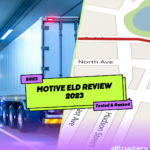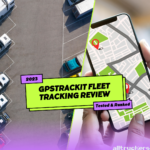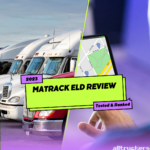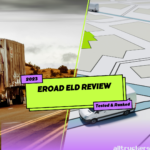Non-compliance with electronic logging device (ELD) regulations can result in serious consequences for commercial truck drivers and their companies. ELDs are designed to ensure that drivers are complying with federal hours-of-service (HOS) regulations, which limit the amount of time drivers can spend on the road without taking a break. While ELDs have been mandatory for most commercial vehicles since December 2019, some drivers and companies still fail to comply with the regulations.
The Federal Motor Carrier Safety Administration (FMCSA) enforces ELD regulations, and drivers who fail to comply can face fines and other penalties. For example, drivers who do not have an ELD installed in their vehicle can be fined up to $1,000 per offense. Similarly, drivers who are found to be using a non-compliant ELD can be fined up to $10,000 per offense. In addition to fines, non-compliance can also result in a driver being placed out of service until they can demonstrate compliance. This can be costly for both the driver and their company, as it can result in lost time and revenue.
What are Electronic Logging Devices?
Electronic Logging Devices (ELDs) are electronic devices used to record a driver’s Record of Duty Status (RODS) electronically. These devices are designed to replace traditional paper logbooks and make it easier for motor carriers to accurately track, manage, and share records of duty status (RODS) data.
ELDs are mandated by the Federal Motor Carrier Safety Administration (FMCSA) as part of the ELD rule, which is intended to create a safer work environment for drivers and ensure compliance with Hours of Service (HOS) regulations.
ELDs monitor a driver’s driving time and Hours of Service (HOS) compliance by recording data such as engine hours, vehicle movement, and location. This information is then used to generate an accurate log of the driver’s RODS, which can be easily accessed and shared with law enforcement officials, inspectors, and other authorized personnel.
It is important to note that not all motor carriers are required to use ELDs. There are certain exemptions to the ELD rule, such as for drivers who operate vehicles that are older than model year 2000, or for drivers who operate under the short-haul exception. However, it is important for motor carriers to understand the exemptions and ensure that they are in compliance with all applicable regulations.
Overall, ELDs are an important tool for ensuring compliance with HOS regulations and improving safety on the roads. By accurately tracking a driver’s RODS, motor carriers can help prevent driver fatigue and reduce the risk of accidents caused by tired drivers.
Benefits of ELDs
Electronic Logging Devices (ELDs) have become mandatory for commercial motor vehicles to ensure compliance with federal regulations. However, ELDs offer more than just compliance benefits. Here are some of the benefits of ELDs:
Accurate Records of Duty Status
ELDs help drivers to accurately record their hours of service (HOS) and stay compliant with federal regulations. ELDs automatically record the driver’s location, engine hours, and vehicle miles, which eliminates the need for manual recording of HOS on paper logs. This feature reduces the risk of errors in HOS recording, which can lead to violations and fines.
Improved Fleet Management
ELDs provide fleet managers with real-time data on their drivers’ HOS, vehicle location, and other critical information. This data helps fleet managers to optimize their operations, reduce costs, and improve safety. Fleet managers can use ELD data to identify areas for improvement in their operations, such as reducing idle time, improving fuel efficiency, and optimizing routes.
Reduced Paperwork
ELDs eliminate the need for paper logs, which reduces the amount of paperwork drivers and fleet managers need to manage. ELDs automatically record and store HOS data, which can be easily accessed and shared with safety officials during inspections. ELDs also reduce the risk of lost or damaged paper logs, which can result in violations and fines.
Improved Safety
ELDs improve safety by reducing the risk of fatigue-related accidents. ELDs help drivers to manage their HOS and avoid driving when fatigued. ELDs also improve safety by providing real-time data on vehicle location and HOS, which helps fleet managers to identify and address safety issues.
Compliance with Federal Regulations
ELDs help drivers and fleet managers to stay compliant with federal regulations. ELDs are certified and meet technical specifications set by the Federal Motor Carrier Safety Administration (FMCSA). ELDs also support the transfer of data and supporting documents, which makes it easier for drivers and fleet managers to comply with record-keeping requirements.
In summary, ELDs offer numerous benefits beyond compliance. ELDs provide accurate records of duty status, improve fleet management, reduce paperwork, improve safety, and ensure compliance with federal regulations. ELDs are an essential tool for drivers and fleet managers to optimize their operations and stay compliant with federal regulations.
Hours of Service (HOS) Regulations
The Hours of Service (HOS) regulations are federal rules that govern the maximum amount of time commercial drivers can spend driving and working. These regulations are designed to reduce the risk of driver fatigue and improve safety on the roads.
Under the HOS regulations, drivers are limited to a certain number of hours on duty, including driving time, and must take mandatory rest breaks. The specific requirements vary depending on the type of driver and the type of cargo being transported.
For example, drivers of property-carrying vehicles are limited to 11 hours of driving time after 10 consecutive hours off duty, while drivers of passenger-carrying vehicles are limited to 10 hours of driving time after 8 consecutive hours off duty.
In addition to driving time limits, the HOS regulations also require drivers to take a 30-minute break after 8 hours of driving and to take a minimum of 10 hours off duty between shifts.
It is important for motor carriers and drivers to comply with the HOS regulations to avoid penalties and fines. Failure to comply with the HOS regulations can result in violations, which can lead to fines, increased insurance rates, and even the loss of a commercial driver’s license.
Electronic Logging Devices (ELDs) are used to track compliance with the HOS regulations. ELDs automatically record a driver’s driving time and duty status, making it easier for drivers and carriers to comply with the regulations. However, ELD malfunctions can occur, and it is important for drivers and carriers to be aware of the procedures for addressing these malfunctions to avoid violations.
ELD Technical Specifications
Electronic Logging Devices (ELDs) must comply with the technical specifications set forth by the Federal Motor Carrier Safety Administration (FMCSA) in order to be considered compliant with the ELD mandate. These technical specifications ensure that ELDs are capable of accurately recording and transmitting data related to driving time, engine hours, and other important data elements.
ELDs are required to meet certain performance and design standards, including the ability to automatically record driving time, engine hours, and other data elements. They must also be capable of transmitting data to safety officials upon request, and must be tamper-resistant to prevent drivers from altering or deleting records.
One important aspect of ELD technical specifications is the requirement for engine synchronization compliance monitoring. This requires the ELD to record an engine synchronization diagnostics event when it cannot acquire values for the ELD parameters within 5 seconds of the need. Additionally, the ELD must set a power compliance malfunction if the power data diagnostics event indicates an aggregated in motion driving time understatement of 30 minutes or more on the ELD over a 24-hour period across all driver profiles, including unidentified driver profile.
ELDs are also required to comply with certain data element requirements, including recording the driver’s duty status and the date and time of each change in duty status. They must also record the location of the commercial motor vehicle (CMV) at each change of duty status, and must be capable of automatically recording the CMV’s engine power status, vehicle motion status, and miles driven.
Fleet management systems must also comply with ELD technical specifications in order to ensure that they are capable of receiving and storing ELD data. Additionally, ELDs must comply with model year 2000 or newer vehicle requirements, and must be capable of being integrated with other onboard recording devices, such as Automatic On-Board Recording Devices (AOBRDs).
Overall, compliance with ELD technical specifications is crucial for ensuring that ELDs are capable of accurately recording and transmitting data related to driving time, engine hours, and other important data elements. Fleet managers and drivers should consult the FMCSA’s FAQs and technical specifications to ensure that their ELDs are compliant with the ELD mandate.
ELD Malfunctions and Compliance
Electronic logging devices (ELDs) have been mandatory for most commercial motor vehicles in the United States since December 2017. ELDs are designed to improve safety on the roads by accurately recording drivers’ hours of service (HOS) and ensuring that they comply with federal regulations. However, ELD malfunctions can occur, and it’s essential to understand how to handle them to remain compliant with the ELD final rule.
If an ELD malfunctions, the driver must take immediate action to correct the issue. The driver must annotate the ELD record to explain the malfunction and the steps taken to correct it. The driver must also reconstruct the record of duty status (RODS) for the current 24-hour period and the previous seven consecutive days, using the best information available and the ELD data that are available.
If the ELD malfunction cannot be corrected immediately, the driver must continue to manually prepare RODS until the ELD is repaired or replaced. The driver must also provide the motor carrier with a written report of the malfunction within 24 hours of discovering the issue. The report must include the date and time of the malfunction, a description of the malfunction, and the steps taken to correct it.
It’s important to note that if an ELD malfunction occurs, the driver is still responsible for complying with the HOS regulations. If the ELD is not functioning correctly, the driver must rely on paper logs to record their HOS until the issue is resolved.
In the event of a data diagnostic event, the ELD can no longer record or retain required events or retrieve recorded logs that are not kept remotely by the motor carrier. In such cases, the driver must take immediate action to correct the issue and annotate the ELD record to explain the malfunction. The driver must also reconstruct the RODS for the current 24-hour period and the previous seven consecutive days, using the best information available and the ELD data that are available.
In conclusion, compliance with ELD regulations is crucial for commercial motor vehicle drivers and motor carriers. ELD malfunctions can occur, but drivers must take immediate action to correct the issue and remain compliant with the ELD final rule. If an ELD malfunction occurs, the driver must annotate the ELD record, reconstruct the RODS, and provide a written report of the malfunction to the motor carrier.
Real-time GPS Tracking
Real-time GPS tracking is a critical feature of electronic logging devices (ELDs) that helps fleet managers stay on top of their vehicles’ locations and statuses. With real-time GPS tracking, fleet managers can monitor their drivers’ activities and ensure that they are complying with hours of service (HOS) rules, which limit the amount of time a driver can spend behind the wheel.
Real-time GPS tracking also helps fleet managers improve productivity by identifying inefficiencies and optimizing routes. By analyzing real-time data, fleet managers can make informed decisions about which routes to take and which drivers to assign to specific jobs.
In addition, real-time GPS tracking can help fleet managers comply with International Fuel Tax Agreement (IFTA) requirements by accurately tracking the distance traveled in each state or province. This information is critical for calculating fuel taxes and ensuring compliance with state and provincial regulations.
ELDs with real-time GPS tracking can transmit data wirelessly to a USB or wireless web service, making it easy for fleet managers to access and analyze data in real-time. This feature is especially important for compliance with the MAP-21 and Commercial Motor Vehicle Safety Enhancement Act, which require ELDs to transmit data in real-time to ensure compliance with interstate commerce regulations.
There are some exceptions to the ELD mandate, including short-haul exceptions, drive-away-tow-away operations, and special driving categories such as motor homes and recreation vehicle trailers. Vehicles manufactured before model year 2000 and those with pre-2000 engines are also exempt from the ELD mandate.
It is important to note that not all ELDs are created equal. Fleet managers should ensure that their ELDs are registered devices that meet the requirements for ELD certification. By selecting a high-quality ELD with real-time GPS tracking, fleet managers can ensure compliance with regulations and improve their operations.
ELD Requirements and Installation
To comply with the Federal Motor Carrier Safety Regulations, commercial motor vehicle drivers must install self-certified ELDs in their vehicles. These ELDs must meet specific key requirements, such as recording the driver’s hours of service (HOS), miles driven, vehicle motion status, and geo-location.
Drivers who operate under the short-haul exception or who drive vehicles manufactured before the year 2000 are exempt from the ELD mandate. However, those who are required to use ELDs must install them properly and ensure they are working correctly.
ELD installation involves connecting the device to the vehicle’s engine control module and real-time GPS tracking system. Dispatchers and enforcement personnel can access the ELD systems to check the driver’s hours-of-service records and ensure compliance with federal regulations.
Owner-operators who fail to comply with ELD regulations may face corrective action, including fines and penalties. In addition to complying with federal regulations, ELDs can also improve fuel efficiency and provide coaching to drivers to help them drive more safely.
Recreational vehicle and livestock drivers are not required to use ELDs, but they must still comply with hours-of-service regulations and keep accurate records. Drivers who operate outside of their home terminal must also comply with ELD regulations.
Overall, complying with ELD regulations is essential for commercial motor vehicle drivers to avoid penalties and ensure safety on the road.














